The Radeon R9 280X Review: Feat. Asus & XFX - Meet The Radeon 200 Series
by Ryan Smith on October 8, 2013 12:01 AM ESTOverclocking
With our look at the stock performance of our 280X cards complete, let’s take a brief look at overclocking.
When it comes to overclocking this is going to be a somewhat unfair competition for the two cards. The Asus card has by the very necessity of its existence already been binned. Furthermore while the Asus card supports voltage adjustments the XFX card does not (MSI Afterburner says it does, but adjusting the value has no effect). As such we get to drive what’s already a better GPU harder and with more voltage than the other. Still, this will give us the chance to see where everything will top out at.
| Radeon R9 280X Overclocking | ||||
| XFX Radeon R9 280X DD | Asus Radeon R9 280X DCU II TOP | |||
| Shipping Core Clock | 850MHz | 970MHz | ||
| Shipping Boost Clock | 1000MHz | 1070Mhz | ||
| Shipping Memory Clock | 6GHz | 6.4GHz | ||
| Shipping Boost Voltage | 1.2v | 1.2v | ||
| Overclock Core Clock | 880MHz | 1010MHz | ||
| Overclock Boost Clock | 1030MHz | 1110MHz | ||
| Overclock Memory Clock | 6.6GHz | 6.8GHz | ||
| Overclock Max Boost Voltage | 1.2v | 1.263v | ||
As it turns out, neither card overclocked by very much. The XFX card, lacking additional voltage, could only do 30MHz more, for a 4% base/3% boost overclock. Better luck was found on the memory with a 600MHz (10%) overclock there. The Asus card meanwhile was good for 40MHz more, for a 4% base/4% boost overclock, while its memory could do an additional 800MHz (13%). But at the same time this required dialing the voltage up to 1.263v – as high as we’re willing to go for this card. The power cost of doing that will be extreme.
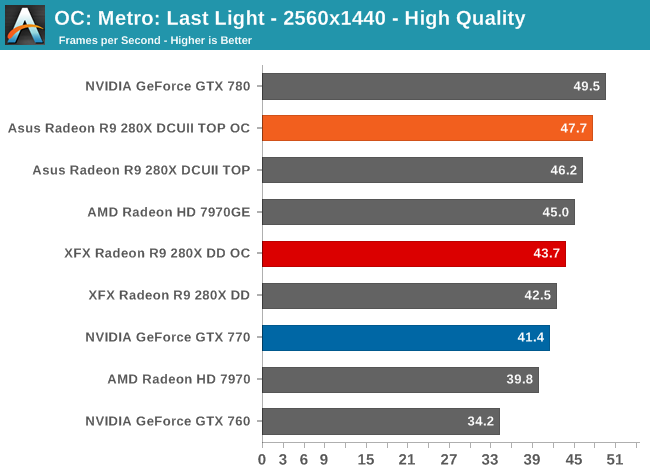
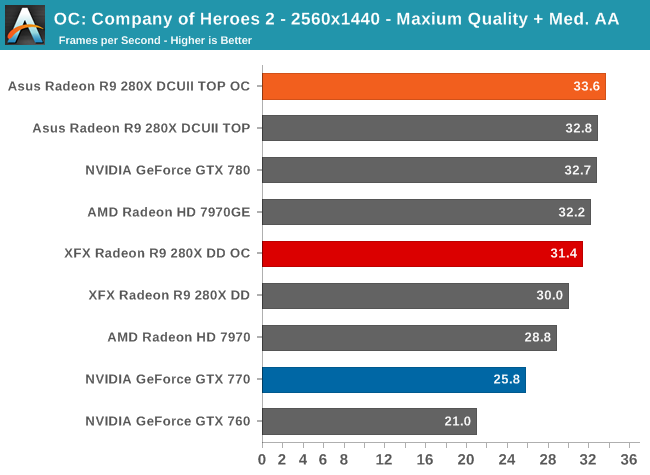
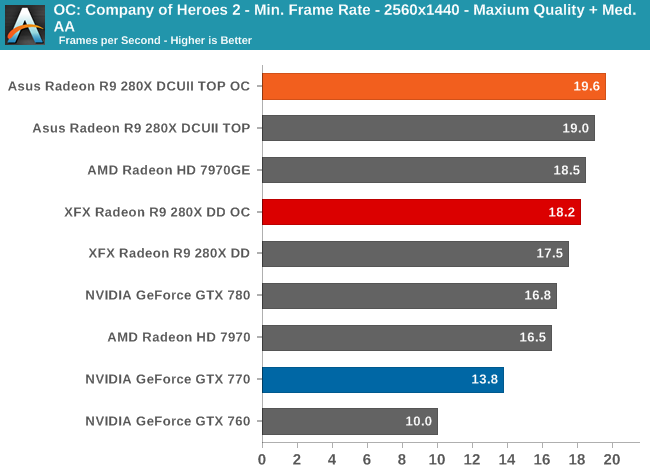
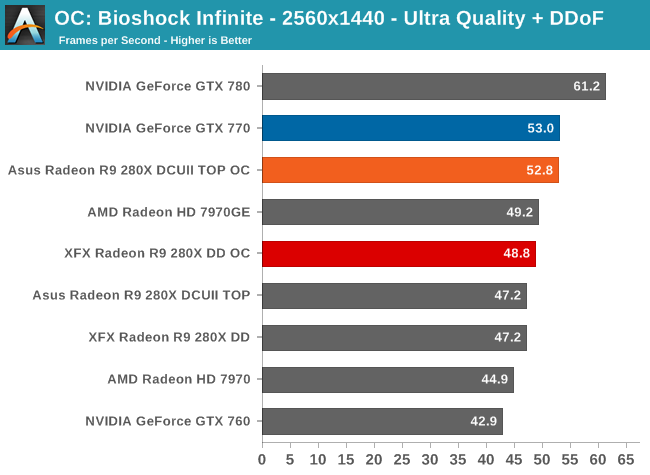
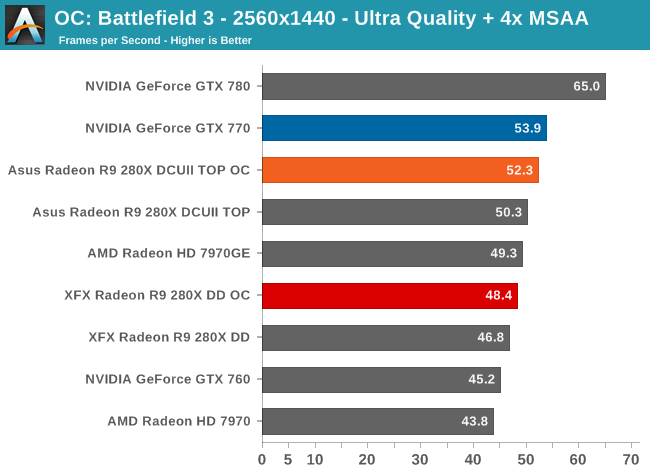
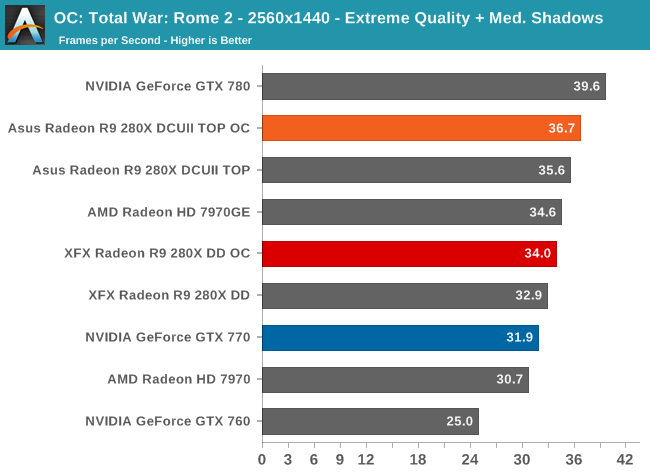
With our 280X cards primarily bottlenecked by GPU performance as opposed to memory performance, the performance gains from our overclocking adventure is limited. 3% on average for both cards is 3% for free, but it’s barely a useful overclock. We typically need 5% before overclocks start becoming interesting and significant enough to improve playability or make higher graphical settings practical.
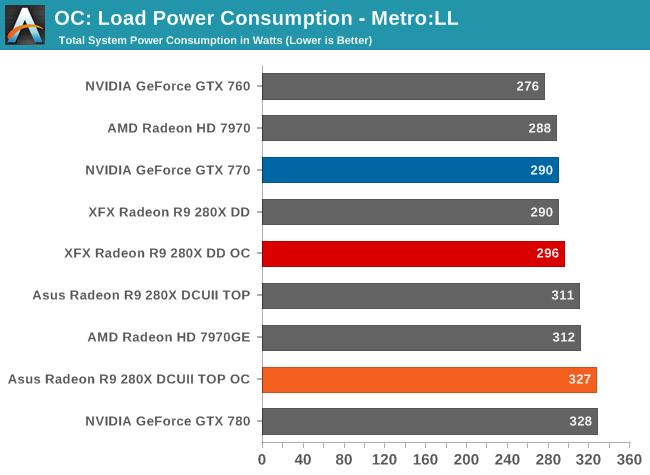
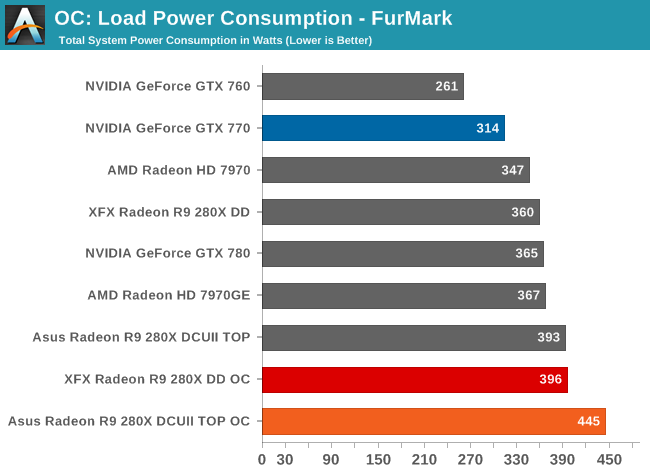
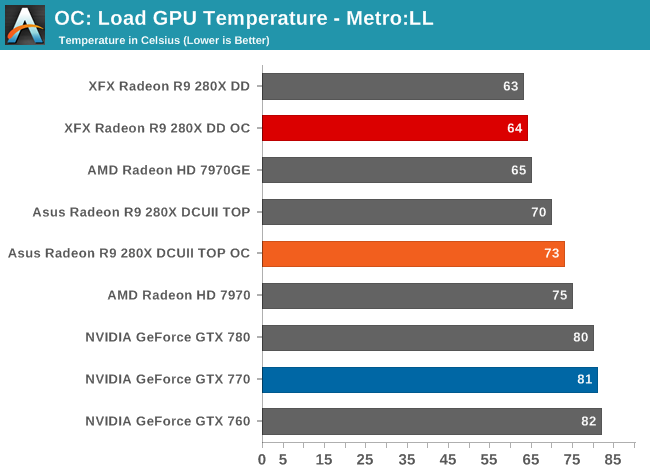
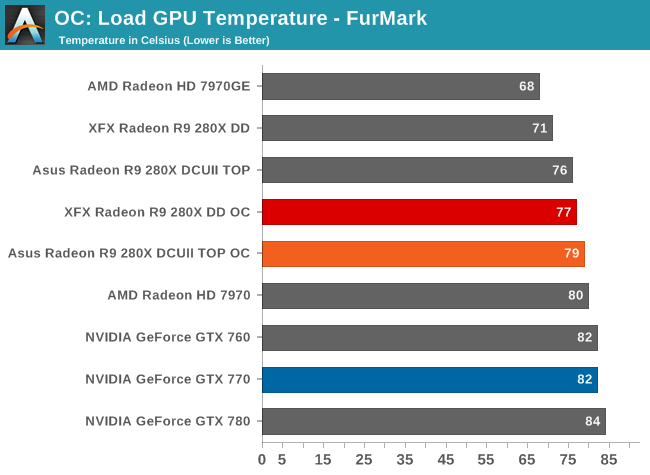
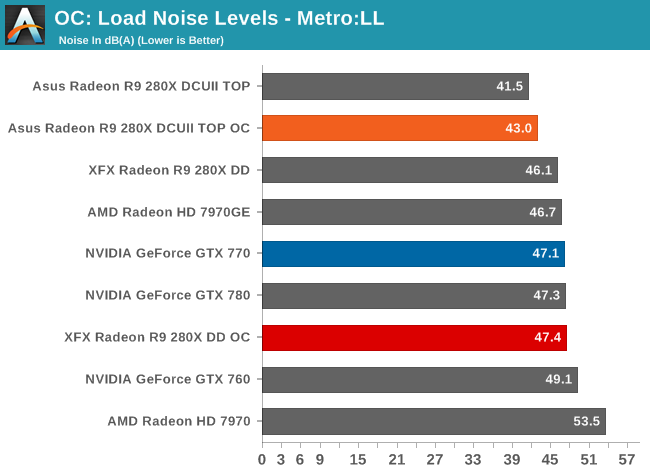
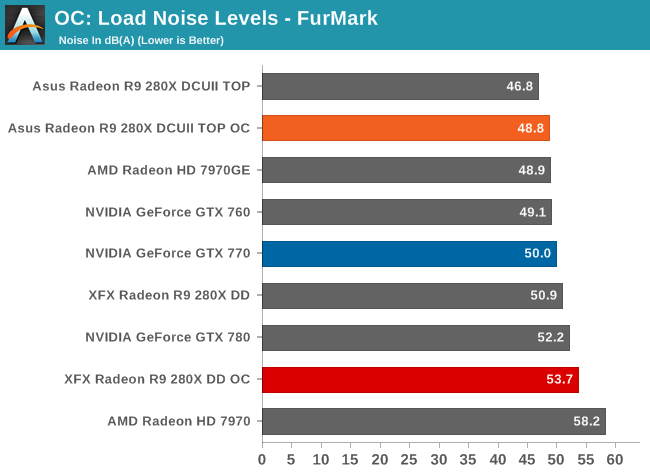
To the credit of the Asus card and its cooler, despite the increased clockspeeds, voltage, and power consumption, it’s able to keep GPU temperatures and load noise to reasonable levels given the circumstances. Still, with the increase in power required to achieve this overclock (particularly in the worst case scenario of FurMark) it’s hard to argue that the additional overclocking was worth the performance gains. With such an extensive factory overclock this is a card that may be better off left at factory clocks.
The XFX card meanwhile suffers much less of a power ramp up due to the lack of voltage control, but we’re still looking at something of a wash on the power/performance front.










151 Comments
View All Comments
varad - Tuesday, October 8, 2013 - link
Last 2 sections are missingA5 - Tuesday, October 8, 2013 - link
As is the [Product Specs] Table on Page 1.varad - Tuesday, October 8, 2013 - link
Looks like there are many more diagrams and charts missingyacoub35 - Tuesday, October 8, 2013 - link
Yep. Article was probably set to auto-post but the associated images (and apparently the last two pages) are missing.Anyway, the gist of this seems to be that the 280X is the price and performance the 7970 should have been two years ago. But since they went with crazy-high pricing on the 7900 series, they can now release this product at the price point that would have been appropriate two years ago and still make out like bandits with reworked 7900 hardware which must be exceptionally cheap for them to produce at this age of maturity on the fabs. Good for their revenue, but probably not going to entice NVidia to drop their prices much.
If this is what we're getting as top-of-the-line in the normal-people price bracket from AMD, it makes me happy I picked up a 7970 on a great sale recently.
Now we can watch the 290X, which should be $399, $100 more or less than the 280X in keeping with the normal pricing separation between models, come in around $549 instead. What a joke.
Spoelie - Tuesday, October 8, 2013 - link
How is that different from EVERY OTHER COMPANY out there? What about NVIDIA to introduce Titan at a 1000 when their next highest card was at 500?Prices are dictated by competitive landscape and demand/price curves, maximizing profit - not by what you want it to cost, or some mathematical ideal of "perfect 100$ separation". Don't like it, don't buy it.
Galidou - Tuesday, October 8, 2013 - link
+1 for Spoelieblanarahul - Tuesday, October 8, 2013 - link
Am I the only when who is happy that we finally get a long awaited price cut? The stores in my country don't drop prices like the Americans' do. So for me, it's a great time to upgrade. GPU power has never been so cheap!blanarahul - Tuesday, October 8, 2013 - link
Correction: "Am I the only 'one' who is happy....."Sigh. Brain fart.
HisDivineOrder - Wednesday, October 9, 2013 - link
I don't think I saw him comment on how much he was glad nVidia wasn't like AMD. I'm pretty sure he was just commenting on how AMD was doing something he didn't like.No need to kneejerk defend AMD, friend. Just allow him to be annoyed with AMD for doing something that is annoying. When nVidia does it, he can be annoyed with them, too. Nothing in his post screams, "nVidia's okay when they do it!"
Galidou - Saturday, October 12, 2013 - link
yacoub35's comment was plain stupid and lacked of analysis he says: ''280X is the price and performance the 7970 should have been two years ago. But since they went with crazy-high pricing on the 7900 series''. Nope, 7970 price was higher at launch like every other card for a reason, it was the new stuff. Like many generation, a new card replaces the old king at or a little Under it's price to let the old king on the shelves sell for a reasonable amount. Difference from before is that the price cut happens during the life of the video card because they live longer on the shelves. So when the new stuff comes out, the old stuff is priced already correctly so no one feels SOO bad for buying a video card a month before new ones come out and lower the prices by a LARGE amount.